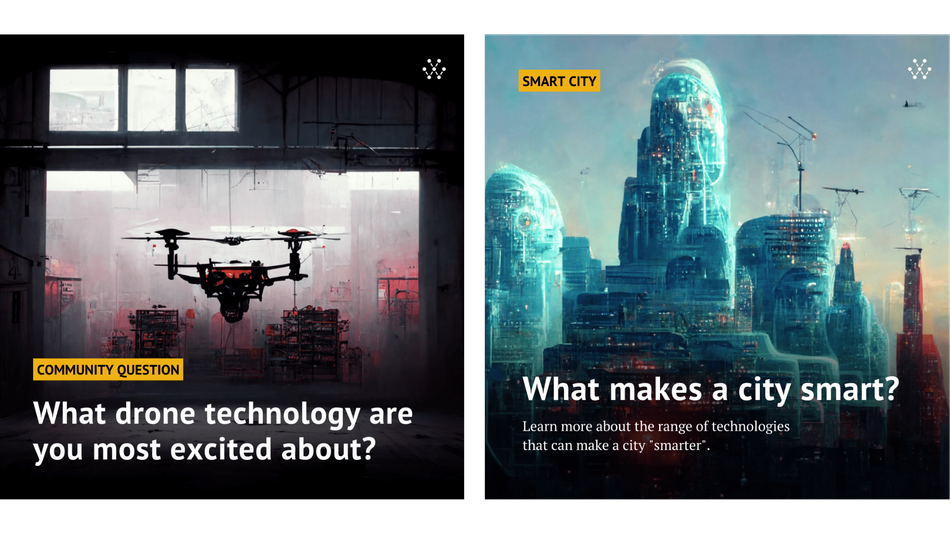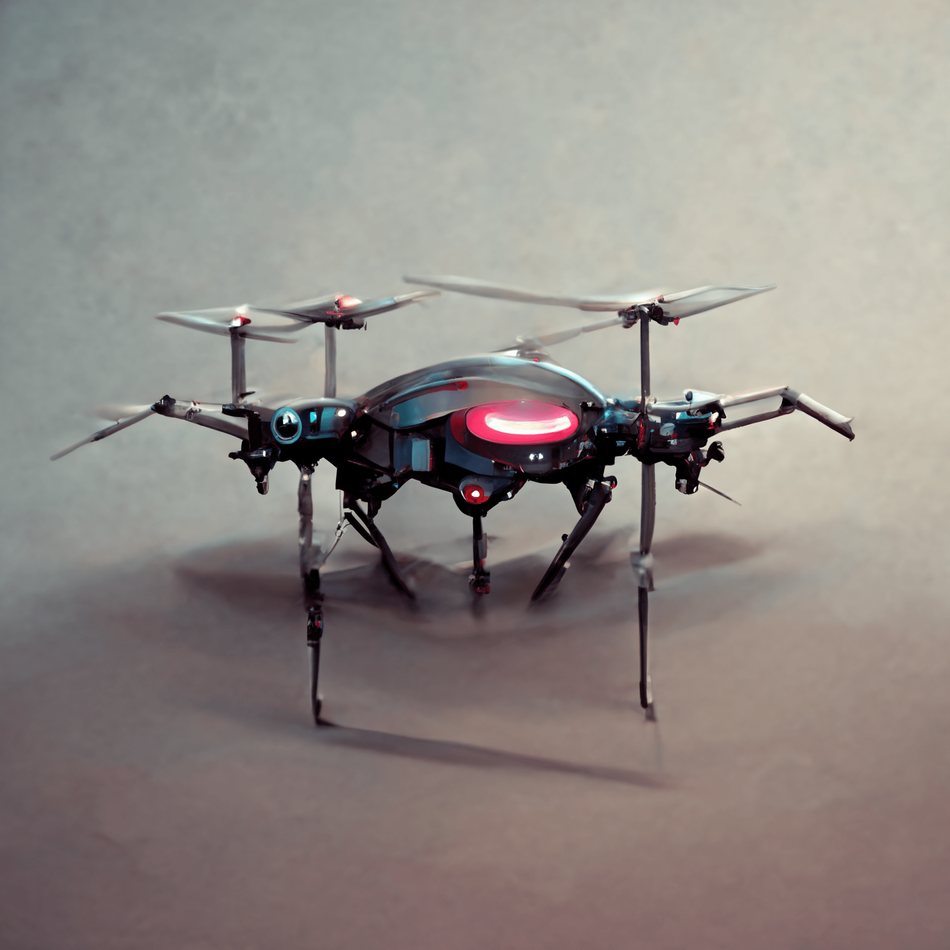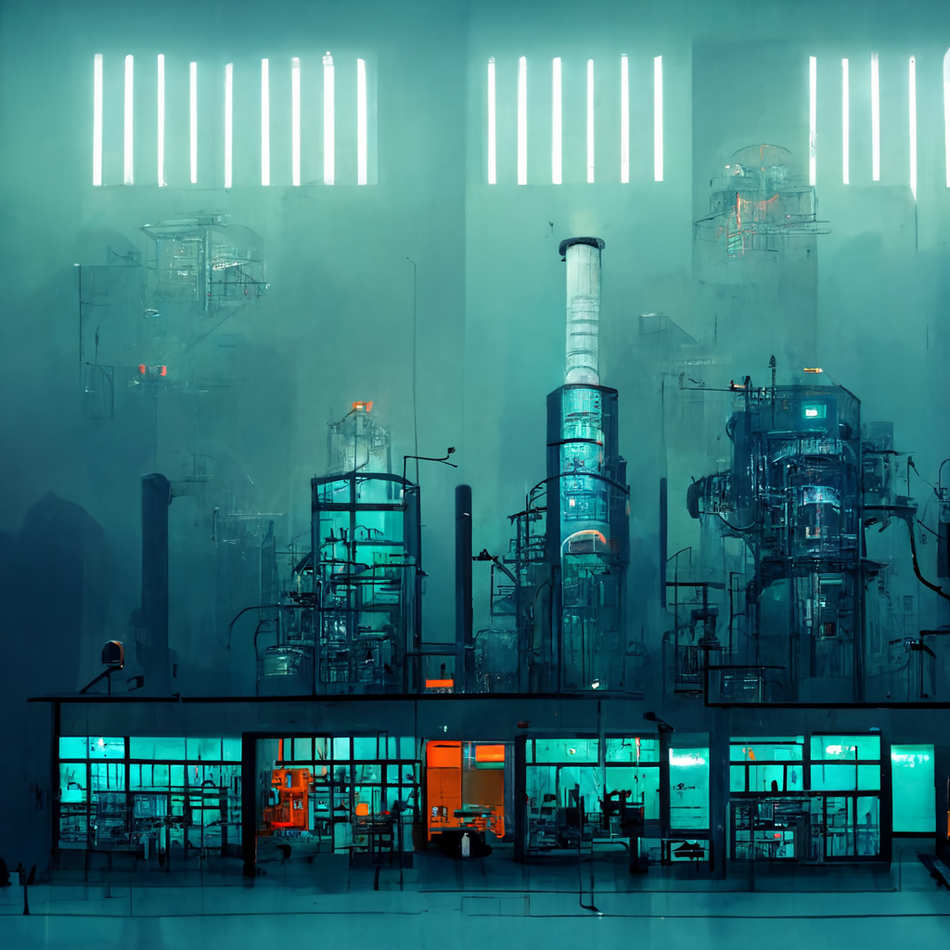Wevolver to use Midjourney to enhance its articles and storytelling
Art and science are usually thought of as opposites. AI-powered systems like MidJourney smash that paradigm out of the water.

Image created by Wevolver staff using Midjourney.
What is Midjourney?
Midjourney is an independent research lab[1] creating an AI creative platform that can turn text prompts into detailed images. For example, we added the prompt "drone technology robotics futuristic" which led to Midjourney creating the image below:
Having launched its open beta in July 2022, Midjourney aims to explore "new mediums of thought and expand the imaginative powers of the human species." The lab was founded by David Holz, formerly the founder at Leap Motion, and an ex-researcher at the Max Planck Institute and NASA.
Midjourney have an impressive lineup of talent on their side. Beyond their 11 full time staff, notable names on the advisory board include Jim Keller, Lead Silicon at Apple, AMD, Tesla, and Intel, Bill Warner, inventor of non-linear video editing, Nat Friedman, the CEO at Github, and Philip Rosedale, the CTO of RealNetworks.
When so many goliaths of the tech world get together, it's usually for good reason.
At Wevolver we believe this technology will have a big impact on the way people will create creative content in the future. Therefore, we ourselves are also going to start using Midjourney to augment our content creation team. We often struggle with finding interesting visuals for articles or social media posts, ironically AI being one of those. Some topics are simply too high level, or conceptual to find a fitting image for. MidJourney can help us by creating both ideas for visual material, as well as the actual visuals as well.
How does Midjourney work?
Midjourney is still in its Beta phase - meaning it is undergoing mass testing in free internet space. At the moment, the only way to access it is via a Discord server[2].
To have a go yourself, type "/imagine prompt:" followed by a description of the art you'd like created. The MidJourney bot then creates four images, giving you the option to get variations (V) or upscales (U) of any of the four outputs.
Upscaling creates more detailed and higher-resolution images. As you tinker with the first drafts, more options become available to further hone the image to your vision, such as Make Variation, Upscale to Max, Light Upscale Redo[3].
Requesting variations of an image allows you to go down a rabbit hole of an idea. This function basically tells the bot to create four new variations of the image you selected. Think of it a bit like natural selection - the best idea makes it to the next generation.
If you don't like any of the images the AI bot creates for you, simply hit "Redo" and it will try again using the original prompt.
Midjourney has been compared to other AI-powered systems that create images from user inputs, most notably, OpenAI's DALL-E. The advantage MidJourney has though is that it is free and available to the public, whereas users have more hoops to jump through to access DALL-E 2.
Midjourney operates on a freemium model, with paid plans starting at $10 per month for 200 images. It's worth mentioning that all outputs are stored in the public domain unless licensing is bought for them.
AI’s relationship to the artist
Perhaps unsurprisingly, the release of Midjourney into the public domain hasn't come quietly. Artists across the globe have expressed their discontent with what they see as another win for AI, at the expense of human artists, in the battle for creativity.
The question of copyright, effort, and fair payment is a legitimate one.
Recently, The Atlantic used an image created by MidJourney as their cover art. The writer responsible, Charlie Wertzel[4], came under fire, and criticized for taking jobs away from actual artists. He is not alone in his high-profile use of the AI bot. The Economist has also used Midjourney-generated art on its covers in recent months[5].
Speaking about a similar AI-powered text to image bot, Wertzel writes, “DALL-E is trained on the creative work of countless artists, and so there’s a legitimate argument to be made that it is essentially laundering human creativity in some way for commercial product.”[6] The ethical argument is that the AI is trained on human artists' work, and then creating products that cut off said artists from getting both the credit and the coin.
However, as with any new development, with the bad comes the good. Several artists are using Midjourney to bring their imaginations to life in new and previously impossible ways[7]. It can elevate their inspiration and help them create more art, faster. Some users are using MidJourney to create entire graphic novels. Plus, isn't creativity all about connecting the dots in ways no one has thought to before? In that case, perhaps this doesn't take away from art, it just creates a new genre, where the emphasis is placed on the concept behind the prompt rather than the technical skill required to execute the piece.
Why do we at Wevolver want to use Midjourney?
At Wevolver, we have started using Midjourney to supplement our articles with images. There are a few reasons behind this decision:
- A source of new, fresh, and illustrative images about engineering. Let's be honest, stock images can only last you so long before they start looking tired or repeating themselves!
- We want to explore AI tools to our advantage while also getting our audience interested in these tools
- Technically we have an unlimited choice of images.
- We want to share interesting content, and Midjourney can provide that in a way no other standard image site can
- It also allows us to share project images from MidJourney to our community, that they can then also use freely as all images are public domain

Conclusion
AI-generated images have long been present on the internet, but the roll-out of Midjourney, backed by such high-profile tech players means this is likely the beginning of something great. While it causes understandable uncertainty in the art world, it seems an inevitable part of the future of creativity.
References
1. Midjourney [Internet]. Midjourney. Available from: https://www.midjourney.com/home/#about
2. Titov A. Midjourney as an artificial intelligence system [Internet]. stepico. 2022 [cited 2022 Sep 28]. Available from: https://stepico.com/blog/midjourney-as-an-artificial-intelligence-system/
3. G H. Midjourney – Start your Journey | Weird Wonderful AI Art [Internet]. Weird Wonderful AI Art. 2022 [cited 2022 Sep 28]. Available from: https://weirdwonderfulai.art/general/midjourney-start-your-journey/
4. Warzel C. I Went Viral in the Bad Way [Internet]. The Atlantic. 2022 [cited 2022 Sep 28]. Available from: https://newsletters.theatlantic.com/galaxy-brain/62fc502abcbd490021afea1e/twitter-viral-outrage-ai-art/
5. How a computer designed this week’s cover [Internet]. The Economist. 2022 [cited 2022 Sep 28]. Available from: https://www.economist.com/news/2022/06/11/how-a-computer-designed-this-weeks-cover
6. Ibid [4]
7. Rawat N. Midjourney AI Art Generator Is Going To Put Artists Out Of Work [Internet]. Fossbytes. 2022 [cited 2022 Sep 28]. Available from: https://fossbytes.com/midjourney-ai-art-generator-is-going-to-put-artists-out-of-work/



